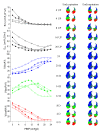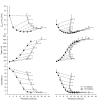Optimizing positive end-expiratory pressure by oscillatory mechanics minimizes tidal recruitment and distension: an experimental study in a lavage model of lung injury
- PMID: 23134702
- PMCID: PMC3672594
- DOI: 10.1186/cc11858
Optimizing positive end-expiratory pressure by oscillatory mechanics minimizes tidal recruitment and distension: an experimental study in a lavage model of lung injury
Abstract
Introduction: It is well established that during mechanical ventilation of patients with acute respiratory distress syndrome cyclic recruitment/derecruitment and overdistension are potentially injurious for lung tissues. We evaluated whether the forced oscillation technique (FOT) could be used to guide the ventilator settings in order to minimize cyclic lung recruitment/derecruitment and cyclic mechanical stress in an experimental model of acute lung injury.
Methods: We studied six pigs in which lung injury was induced by bronchoalveolar lavage. The animals were ventilated with a tidal volume of 6 ml/kg. Forced oscillations at 5 Hz were superimposed on the ventilation waveform. Pressure and flow were measured at the tip and at the inlet of the endotracheal tube respectively. Respiratory system reactance (Xrs) was computed from the pressure and flow signals and expressed in terms of oscillatory elastance (EX5). Positive end-expiratory pressure (PEEP) was increased from 0 to 24 cm H2O in steps of 4 cm H2O and subsequently decreased from 24 to 0 in steps of 2 cm H2O. At each PEEP step CT scans and EX5 were assessed at end-expiration and end-inspiration.
Results: During deflation the relationship between both end-expiratory and end-inspiratory EX5 and PEEP was a U-shaped curve with minimum values at PEEP = 13.4 ± 1.0 cm H2O (mean ± SD) and 13.0 ± 1.0 cm H2O respectively. EX5 was always higher at end-inspiration than at end-expiration, the difference between the average curves being minimal at 12 cm H2O. At this PEEP level, CT did not show any substantial sign of intra-tidal recruitment/derecruitment or expiratory lung collapse.
Conclusions: Using FOT it was possible to measure EX5 both at end-expiration and at end-inspiration. The optimal PEEP strategy based on end-expiratory EX5 minimized intra-tidal recruitment/derecruitment as assessed by CT, and the concurrent attenuation of intra-tidal variations of EX5 suggests that it may also minimize tidal mechanical stress.
Figures




References
-
- Briel M, Meade M, Mercat A, Brower RG, Talmor D, Walter SD, Slutsky AS, Pullenayegum E, Zhou Q, Cook D, Brochard L, Richard JC, Lamontagne F, Bhatnagar N, Stewart TE, Guyatt G. Higher vs lower positive end-expiratory pressure in patients with acute lung injury and acute respiratory distress syndrome: systematic review and meta-analysis. JAMA. 2010;16:865–873. doi: 10.1001/jama.2010.218. - DOI - PubMed
-
- The Acute Respiratory Distress Syndrome Network. Ventilation with lower tidal volumes as compared with traditional tidal volumes for acute lung injury and the acute respiratory distress syndrome. N Engl J Med. 2000;16:1301–1308. - PubMed
-
- Mead J, Takishima T, Leith D. Stress distribution in lungs: a model of pulmonary elasticity. J Appl Physiol. 1970;16:596–608. - PubMed
-
- Muscedere JG, Mullen JB, Gan K, Slutsky AS. Tidal ventilation at low airway pressures can augment lung injury. Am J Respir Crit Care Med. 1994;16:1327–1334. - PubMed
Publication types
MeSH terms
LinkOut - more resources
Full Text Sources
Other Literature Sources

